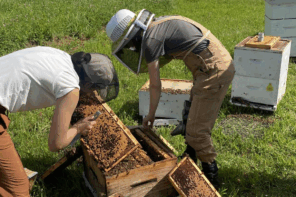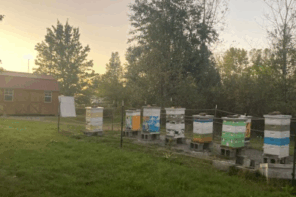10 Rules of Modern Beekeeping
There are, I’m certain, far more than 10 rules that you can use to guide you through the common and mundane, the exciting and dangerous, and the curious and wonderful aspects of keeping bees. That is why this isn’t called The 10 Rules of Modern Beekeeping, just 10 of them. But these 10 are, I am certain quite important, and they do encompass much of what you will encounter in your pursuit of the perfect crop, raising the perfect queen, finding the perfect beeyard, controlling pests and diseases, keeping your bees happy and healthy, and even keeping you happy and healthy in the process. That’s not all of what you’ll need, but it goes a long way in making most things work for you, and for your bees.
There is one rule that isn’t in the next 10 that I’d like to call your attention to before we begin the rest, because it affects every one of these rules, and, is should be said, everything you do with your bees. Even greater, it has to do with pretty much everything you do in the world of planting, growing, raising, nurturing or harvesting any kind of crop you undertake to husband. That includes your yard and garden, your orchard and chicken flock, and absolutely your bees….and that is…all beekeeping, and gardening and farming and dealing with Mother
Nature is Local. In fact, modern agriculture has entered the world of big data. Farmers can now shepard harvesting machines miles away using GPS and satellite technology. They can plant fields, using similar technology, and apply differing amounts and kinds of fertilizers to the wet and dry spots, different seeds to the edges and middle and different seed protection chemicals to the low and high spots…so fine tuned are these machines that one person can, and very soon will I imagine, farm a piece of land the size of Vermont and not have to leave the house.
Beekeeping is no different anymore…well not much different. Even in the county you live in there are places that are rife with the dangers of agricultural chemicals, locations surrounded by asphalt and nothing to eat, and a few places safe from danger, equipped with abundant food all season long. If you look, by walking or driving around, talking to farmers and hunters and land owners and use your own form of GPS technology, you can seek out and find the good places, and with luck and work, avoid the bad places. And when you find those spots they will be different, even in your own county. All beekeeping is local…the weather, the soil, agriculture and the wild plants that grow where they want.
Your job is to first find those spots, and then find out as much as you can that will enable you and your bees to thrive in those spots. We’ll explore some of those requirements here, but first, we need to get started on this task.
So, Rule Number 1.
Have Good Queens.
I know, this sounds too simple, doesn’t it? Of course you want good queens. The performance of your colony is a reflection of the quality of the queen who leads it. No, queens don’t lead colonies, I know that, but a poor queen will live in a colony that doesn’t do as well as it might have, all other things being equal.
So, what makes a good queen? For starters, she should be raised in luxury. That goes all the way back to the grandparents of the worker bees that take care of her from day one. If those workers, those 2 generation back bees were sick, plagued by Varroa and virus and nosema and not enough good food, they’ll not be able to do a 110% job raising the next generation, who, in turn will not do a good job of raising the bees that should be taking care of that queen larva. Strike one.
Strike two is the place she is raised in…is it soaked in Varroa controlling pesticides, saturating her just forming body, destroying her ability to perform at peak later in life, resulting in a shorter than normal life span and requiring the colony to supercede her early in life? Strike two.
And is there enough food? Are the bees that are feeding her well fed? Or are they sacrificing their own protein stores to make just enough to keep her alive so she can eventually mate…and then, not fly far or fast enough? Strike three.
A good queen should be well mated. Extremely well mated I should add. She should be healthy so she flies as good as she can, but there should be a wealth of robust, healthy drones out there for her to mate with. Think of this…a commercial queen producer that raises 200,000 queens or so in a season, needs about 20 drones for every one of those queens. That comes to drones in the millions. How many drone colonies does that producer need to produce that many queens. And, if there are enough drones, are they, too healthy. Varroa control chemicals render drones nearly sterile and unable to mate effectively. Short of food? Even if there are enough colonies, they won’t raise enough drones to supply all those queens. So are they fed, or is the weather OK for flying, or, or, or….there’s a lot than can go wrong with a simple mating flight. And too often it does.
Next, the rest of Rule 1. Have Good Queens.










rule 1a-a knowledgeable beekeeper.thank you mr.flottum for your efforts .i will continue to do my part in sharing this sage advice.
DNA is DNA and if you call forth your divine observer to morph your genetic code from higher instruction it is possible. If this is the case, focus your eyes on the surface of the mud with a little more care and attention.